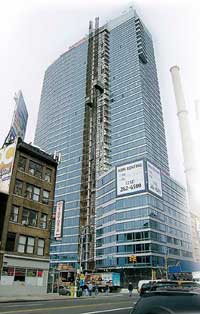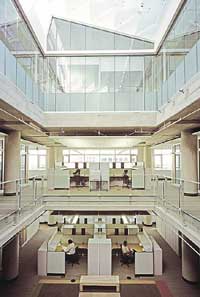...Guenthers team on a $5.7-million diagnostic and treatment center for disabled children in New Yorks Sullivan County. The certified project received fewer points for optimizing energy performance than she had anticipated.
Energy modeling submitted to the council satisfied grant application requirements. But the calculation method was different than the American Society of Heating, Refrigerating and Air-Conditioning Engineers energy standard cited by LEED, making performance seem artificially low, says Guenther.
Such complaints are not falling on deaf ears. Earlier this month the council closed the first public comment period on a revamped LEED that it hopes to launch during the second half of 2005. Version 2.2 will not change the existing structure but is intended to fix credit problems and update reference standards.
 |
|
Smoking Allowed Residential project required credit interpretation.
|
Many familiar with 2.2 say the changes are substantial. For the energy standard, "we entered into direct dialogue with ASHRAE to achieve shared performance goals," says Templeton.
Version 2.2 cites an updated version of ASHRAEs energy standard. It includes a new calculation method that is more appropriate for use when the performance goal is better than code, according to Jason Glazer, president of Gard Analytics, Park Ridge, Ill., and chair of the ASHRAE subcommittee charged with developing the new calculation method. "Now when two buildings claim that energy performance is 20% better than [energy standard] 90.1, we can be assured that both are the same caliber building," he says.
Besides updating LEED, the council is expanding the system. Late last year, it released a version focusing on operation and maintenance of existing buildings and another addressing tenant space construction and renovation. An adaptation tailored to the core and shell of speculative buildings is in pilot phase and versions for homes and new developments are under way.
The council also is developing application guides to make LEED a better fit for different market segments such as health-care, schools and laboratories. The health care application guide, for example, will likely include credits to address the importance of process water in addition to potable water, energy efficiency of medical equipment and issues that impact health of occupants.
"We are looking at LEED through the more precise lens of health care," says Gail Vittori, co-director of the Center for Maximum Potential Building Systems, Austin, and chair of the health care guide committee.
 |
|
Pre-Existing Conditions Nursing school building depends on central campus chiller that uses a banned refrigerant. |
A profound change for LEED would be a move toward a system based on life cycle assessment (LCA), a methodology that evaluates factors such as embodied energy, waste disposal and potential for global warming and ozone depletion of building products and components.
Other rating tools, like BREEAM, rely on LCA (see story, p. 21). "They may be more comprehensive, but are not as easy to implement as LEED," says Stephen Selkowitz, building technologies department head at Lawrence Berkeley National Laboratory, Berkeley, Calif. "There are always tradeoffs."
The first obstacle to adopting LCA is inconsistent protocols and methods used by U.S. manufacturers, says Nigel Howard, USGBC vice president of LEED and international programs. Another hurdle is incorporating "copious quantities" of data "into practical, intuitive and easy to use...tools," he says.
The council recently started working with trade associations, material and product manufacturers and LCA experts to implement the methodology into LEED, says Howard. "This work will not reinvent wheels, but rather adapt appropriately...and support existing initiatives," he says.
| U.K. Pioneer of Environmental Rating Tool for Buildings The granddaddy of environmental rating systems is the U.K.s Building Research Establishment Environmental Assessment Method. International development in environmental ratings broadly sprang from the U.K., says Alan Yates, technical director of The Building Research Establishment Ltd. (BRE), Watford. During the U.K. building boom of the 1980s, developers called on BRE, owned by a not-for-profit trust, for an objective yardstick of energy efficiency. BRE, then a government agency, widened the scope from energy alone to a range of environmental parameters, says Yates. In 1993, BREEAM was relaunched to provide an overall indication of performance, he says. \ In 1998, individual criteria were assigned different weights, to get a more balanced scale, says Yates. A rating of pass, good, very good or excellent is possible. The organization conducts about 100 office building assessments each year, which represent 20 to 25% of the commercial space built, estimates Yates. Among BREEAMs most prominent champions is the U.K. government's regeneration agency, English Partnerships. It requires a "very good" rating for proposed projects on its land. Until an assessment is done satisfactorily, "we dont hand over the freehold," says John Muncaster, a partnership senior urban designer. Since introducing the requirement in 2001, large house builders have warmed to the system, says Muncaster. Once they start doing it and delivering it, they do get quite enthusiastic, he says. But other practitioners detect less industry enthusiasm. There is no driver to stimulate interest in assessment, says Sarah Graham, a registered assessor with W.S. Atkins PLC, Epsom. But she suspects the European Unions new directive on building energy performance may change perceptions. Starting next January, all 25 member states must have tools for assessing energy consumption and must comply with mandatory performance values. Countries are establishing rating tools, and the European Committee for Standardization is working on an EU-wide system, says Brian Anderson, a BRE technical director. |

Post a comment to this article
Report Abusive Comment